Polish fake persona database system. It produces people according to the following database diagram:
It generates convincing email addresses based on given person's data, a valid PESEL number and real-world addresses with usable coordinates.
To deploy the system you need:
PostgreSQL,.NET Core(at least 3.1),Erlang/OTP,Elixir.
The database definition contains a separate postgres user, tables, indexes and triggers. Ubuntu deployment is automated and provided here. On Windows similar procedures apply. After installing Postgres (remember the master password) launch an administrator PowerShell and:
psql -f "./init.sql"
psql -U fakers_u -d fakers_db -f "./tables.sql"
psql -U fakers_u -d fakers_db -f "./triggers.sql"That should prepare what's needed to start the generator.
Written in C# - .NET Core 3.1. Generates person data and persists it in the database. The generator application depends on two external APIs:
https://api.namefake.com/polish-poland/- provides Polish names used as seed for the generator,https://api.geoapify.com/v1- provides geolocation data for real coordinates.
To start generating people data make sure to have a local Postgres database defined as in Database section and run:
cd generator
dotnet run --project EntityGeneratorIt will loop forever until an interrupt is sent. At this point you can start the server to make it internet-available.
As of now, a key is provided within the app. It allows for up to 100K requests/month and is a standard free tier service.
When deploying it in your own environment please obtain your own key and modify generator/ExternalAPI/GetDataFromJson.cs's _geoKEY accordingly.
This will likely change after presentation (23.12.2020) and a separate key will be required.
Written in Elixir. Provides all CRUD operations on the database via GraphQL.
To get it up and running:
cd server
mix deps.get
mix phx.serverThese commands will start the server at your local port 4000.
Written in React.js. It provides info on the project and uses a GraphiQL component to provide a visual way to present and modify data. The client application is hosted here. To deploy your own you need node.js and npm.
Simply npm start in the client directory.
You can feed the client a GraphQL API initially with url parameter - for example:
bart-kosmala.github.io/fakers?api=https://swapi-graphql.netlify.app/.netlify/functions/index
To integrate the client with deployed application simply pass the server's address. At this point it should be:
bart-kosmala.github.io/fakers?api=http://localhost:4000
The application was deployed for presentation purposes on AWS free tier services. Feel free to invest in some long-term hosting to provide constant access.
- Bartosz Kosmala
- Roch Goszczyński
- Jordan Kondracki
- Mateusz Kuźniak
- Hubert Knioła
2020 SEM 5 @ PUT

